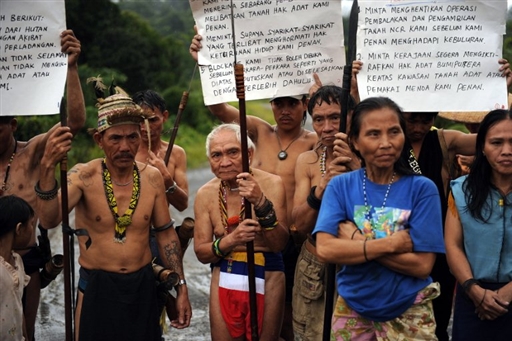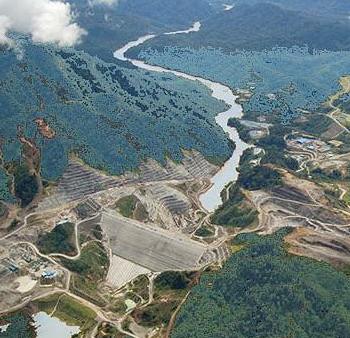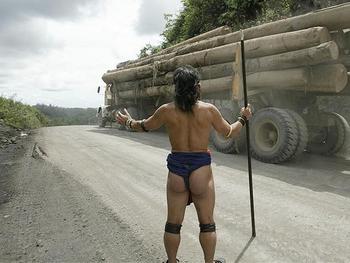cross posted from Environment News Service.

In a picture taken on August 20, 2009, Penan tribespeople man a blockade with banners and spears to challenge vehicles of timber and plantation companies in Long Nen in Malaysia's Sarawak State. Hundreds of Penan tribespeople armed with spears and blowpipes have set up new blockades deep in the Borneo jungles, escalating their campaign against logging, dams, and palm oil plantations. AFP PHOTO/Saeed KHAN
MIRI, Sarawak, Malaysia, February 19, 2012 (ENS) –
Malaysian communities are asking the government to stop all 12 planned mega-dam projects in the state of Sarawak on the island of Borneo and to hold a referendum on dam construction.
A conference of some 150 representatives of indigenous communities and civil society groups concluded Saturday in the city of Miri with demands that the state government address the adverse impact of existing hydroelectric dam projects in Sarawak and stop planning for more to power industrial development of the rainforest.
Organized by the newly formed Save Rivers Network, the conference brought local civil society organizations together with indigenous peoples organizations and concerned individuals for three days. Discussions centered on the adverse impacts of dam construction on the environment and on the livelihoods of dam-affected communities.

Bakun Dam is one of the mega-dams built to power industrial development in Sarawak, Malaysia. (Photo courtesy Bakun National Hydroelectric Project)
“In the workshop discussions, the participants unanimously expressed their clear intent to resolve these issues and continue the campaign until the demands are met,” said Save Rivers Chairman Peter Kallang.
The participants agreed that the government must respect the right of the people to disagree with the proposed dam projects, as they are the ones directly affected.
The delegates called on government to promote micro-hydro, solar, wind and biomass energy generation instead of mega-dams.
They demanded that destructive activities caused by logging, plantation and infrastructure activities within the water catchment areas of all the river systems in Sarawak should cease.
All the participants agreed that the government should, at the very least, conduct a referendum after a full and free consultation among the peoples affected by the dams.
The indigenous communities represented include the Kayans, Kenyahs, Kajangs, Kelabits, Lun Bawangs, Ibans, Penans, Bidayuhs, Kedayans, Trings and Ukits.
They are demanding immediate resolution of all outstanding issues of importance to people affected by the dams that are already in place or currently under construction.
At the close of the conference, the participants issued a statement condemning the Sarawak government’s plans to build an additional 12 dams after Batang Ai, Bengoh, and Bakun dams.

Penan man protests logging truck loaded with timber cut from theSarawak rainforest. The Penan are affected by the Bakun dam. (Photo courtesy Greenpeace)
The 110 meter (360 foot) high dam in Batang Ai National Park in Sarawak, financed by the Asian Development Bank, began operating in 1985. It caused the displacement of some 3,000 people from 26 longhouses. These people have been relocated to cultivate cocoa and rubber but the program has not been successful, says Amarhit Kaur, author of “A History of Forestry in Sarawak.”
The Bengoh dam on Sarawak’s Kiri River is expected to be completed by the end of 2012. Some 250 families involving 1,500 people from four villages are rejecting the government’s resettlement plans to give each family a free house and three acres near the dam. Instead, they preferred to resettle themselves on higher ground upstream of the dam on their traditional territory.
The 63 meter (206 foot) high Bengoh dam is expected to submerge about 8.72 square kilometers (3.3 square miles) of land. Wildlife habitat will be destroyed, affecting two species of hornbill and 50 other species of birds, seven species of bats, 14 species of mammals and 52 species of fish.
Construction was awarded to Naim Cendera, a Malaysian company associated with the family of Sarawak Chief Minister Abdul Taib Mahmud, who is under investigation for corruption.
The Bakun dam on the Balui River in Sarawak is the second-tallest concrete-faced rockfill dam in the world, and Bakun Lake is the biggest lake in Malaysia by storage volume. The 205 meter high (673 ft) dam began generating power in November 2011.
The project, constructed by a consortium led by Swiss company Asea Brown Boveri, required the forced relocation of 12,000 indigenous people, mainly of the Kayan, Kenyah, Kajang, Ukit and Penan ethnic groups.
Residents living near the dam say the river’s living biodiversity has been lost, fish catches are down and the water smells bad and is not safe to drink.
By changing water quality and river flow patterns, the dam will potentially affect the thousands more people living downstream on the Rajang River, the longest in Malaysia.
Energy generated by the Bakun dam will power industries, especially those within the Sarawak Corridor of Renewable Energy, SCORE, one of the five regional industrial development corridors in Malaysia.
Communities argue that there is no need for Bakun’s electricity as Malaysia has a surplus, which will continue for decades.
In Miri, the conference delegates demanded that the state government scrap plans to build more dams and stop bringing “dirty industries” into the state as part of the SCORE industrial corridor.
But that is not likely.
Datuk Amar Wilson Baya Dandot, CEO of the Regional Corridor Development Authority, says, “The corridor is the biggest and most important development plan that has ever been undertaken by the Sarawak Government.”
“Our aim is to optimise the utilisation of natural resources through greater private sector participation, especially from foreign investors,” he says on the SCORE website.
The top eight priority industries identified by Dandot for development in the SCORE corridor are: aluminum, glass, steel, oil-based industry, palm oil, fishing and aquaculture, livestock and timber, all of which have environmental consequences.
To bring economic growth and development to the Central Region and to Sarawak as a whole, Dandot says, “The Government is committed towards upgrading existing infrastructure, infostructure, utilities and amenities and constructing new ones to meet the needs and requirements of investors in the corridor.”

Excellent article about development induced displacement and indigenous issues.
The World Bank estimates that forcible “development-induced displacement and resettlement” now affects 10 million people per year. According to the World Bank an estimated 33 million people have been displaced by development projects such as dams, urban development and irrigation canals in India alone.
India is well ahead in this respect. A country with as many as over 3600 large dams within its belt can never be the exceptional case regarding displacement. The number of development induced displacement is higher than the conflict induced displacement in India. According to Bogumil Terminski an estimated more than 10 million people have been displaced by development each year.
Athough the exact number of development-induced displaced people (DIDPs) is difficult to know, estimates are that in the last decade 90–100 million people have been displaced by urban, irrigation and power projects alone, with the number of people displaced by urban development becoming greater than those displaced by large infrastructure projects (such as dams). DIDPs outnumber refugees, with the added problem that their plight is often more concealed.
This is what experts have termed “development-induced displacement.” According to Michael Cernea, a World Bank analyst, the causes of development-induced displacement include water supply (dams, reservoirs, irrigation); urban infrastructure; transportation (roads, highways, canals); energy (mining, power plants, oil exploration and extraction, pipelines); agricultural expansion; parks and forest reserves; and population redistribution schemes.
Pingback: Underreported Struggles #59, February 2012
Spot on with this write-up, I truly feel this site needs far more attention. I’ll
probably be back again to see more, thanks for the
info!